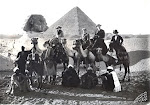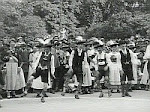
In Ihsan Ihsaan Waahaan now. Excavation is anything but spectacular; i.e., a ditch. Unearthing of burial site will likely have to wait until at least March. Leaves me plenty of time to find local "help." Still, vast potential for boredom here if I do not remain busy. Opportunity to better my Urdu; will also explore Lahore - captivating silks! - and perhaps absorb local mytho history about Mohenjo-daro ("Mound of the Dead"). Delightfully eerie name; perhaps we shall unearth another curse? Perhaps it has already struck, as I find myself out of cigarettes.
Also finding myself wishing that I had someone back home to write (haven't spoken to Rebecca going on three years) but it is probably for the best that I do not.

















1 comment:
(History roll passed; the views below do not necessarily represent contemporary ideas about Harappan civilization and its influence on Vedic religion:)
The history of the Sindh is long and varied. Obviously, it was host to an ancient and possibly widespread civilization, which later came under the influence of conquering horsemen from the steppes of Central Asia. Whatever gods these old civilizations worshiped remain for the most part unknown; the Aryan invaders most likely usurped them and replaced them with their own gods, who later evolved into the Vedic pantheon, still revered today among the Hindu deities.
The Mauryan (Buddhist), Hellenic, and Mughal influences in the area are better documented. This may have something to do with the misinterpretation of site's original discoverer, a Buddhist monk who thought that the conspicuously man-made mound (the very "Mound of the Dead" in question) might have been the remains of an ancient stupa, or Buddhist temple. The name "Mound of the Dead" - perhaps to Pete's disappointment - is not so much a local descriptor as it is a moniker applied to it by overly excited archaeologists.
Post a Comment